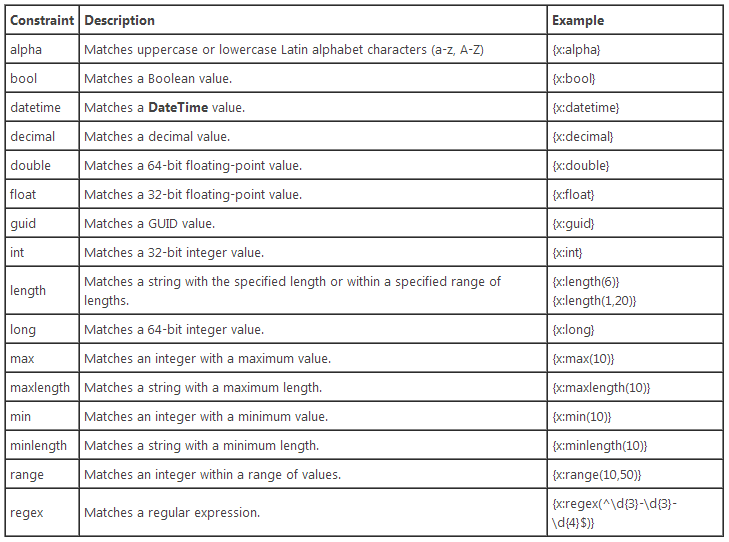Asp.net MVC]Asp.net MVC5系列——Routing特性
目录
系列文章
[Asp.net MVC]Asp.net MVC5系列——第一个项目
[Asp.net MVC]Asp.net MVC5系列——添加视图
[Asp.net MVC]Asp.net MVC5系列——添加模型
[Asp.net MVC]Asp.net MVC5系列——从控制器访问模型中的数据
[Asp.net MVC]Asp.net MVC5系列——添加数据
[Asp.net MVC]Asp.net MVC5系列——在模型中添加验证规则
[Asp.net MVC]Asp.net MVC5系列——实现编辑、删除与明细信息视图
[Asp.net MVC]Asp.net MVC5系列——Razor语法
概述
ASP.NET MVC 5支持一种新的路由协议,称为路由特性。顾名思义,路由特性使用特性来定义路径。路由特性使你的Web应用程序URI有了更多的控制。当然,MVC5也支持以前定义路由的方式,你可以在一个项目中混合使用这两种方式来定义路由。
路由特性
例如,一个电子商务网站可能有以下的路由规则:
{productId:int}/{productTitle}
Mapped to ProductsController.Show(int id)
{username}
Mapped to ProfilesController.Show(string username)
{username}/catalogs/{catalogId:int}/{catalogTitle}
Mapped to CatalogsController.Show(string username, int catalogId)
以往的ASP.NET MVC版本,该规则将设置在routeconfig.cs文件中,并指出实际控制器的Action方法,如:
1 routes.MapRoute(
2 name: "ProductPage",
3 url: "{productId}/{productTitle}",
4 defaults: new { controller = "Products", action = "Show" },
5 constraints: new { productId = "\\d+" }
6 );
当路由的定义与Action方法,在同一个源文件中而不是在外部配置类中声明,它可以更容易的处理URI和行动之间的映射的。以前的路径定义将使用以下,简单的特性就可以达到目的:
1 [Route("{productId:int}/{productTitle}")]
2 public ActionResult Show(int productId) { ... }
使用路由特性
首先得启用Attribute路由,我们可以调用MapMvcAttributeRoutes方法来启用Attribute路由:
1 public class RouteConfig
2 {
3 public static void RegisterRoutes(RouteCollection routes)
4 {
5 routes.IgnoreRoute("{resource}.axd/{*pathInfo}");
6
7 routes.MapMvcAttributeRoutes();
8 }
9 }
也可以和常规的路由设置一起使用。
1 public static void RegisterRoutes(RouteCollection routes)
2 {
3 routes.IgnoreRoute("{resource}.axd/{*pathInfo}");
4
5 routes.MapMvcAttributeRoutes();
6
7 routes.MapRoute(
8 name: "Default",
9 url: "{controller}/{action}/{id}",
10 defaults: new { controller = "Home", action = "Index", id = UrlParameter.Optional }
11 );
12 }
可选URI参数和参数的默认值
可以通过添加“?”标记一个参数为可选的参数,也可以为表单参数设置默认值(参数=value)。
1 public class BooksController : Controller
2 {
3 // eg: /books
4 // eg: /books/1430210079
5 [Route("books/{isbn?}")]
6 public ActionResult View(string isbn)
7 {
8 if (!String.IsNullOrEmpty(isbn))
9 {
10 return View("OneBook", GetBook(isbn));
11 }
12 return View("AllBooks", GetBooks());
13 }
14
15 // eg: /books/lang
16 // eg: /books/lang/en
17 // eg: /books/lang/he
18 [Route("books/lang/{lang=en}")]
19 public ActionResult ViewByLanguage(string lang)
20 {
21 return View("OneBook", GetBooksByLanguage(lang));
22 }
23 }
在上面的例子中,/books和/books/1430210079将路由到View方法,前者将返回所有书的列表信息,后者将返回特定的书的信息。/books/lang和/books/lang/en将采用同样的方式。
路由前缀
在同一个控制器里面,路由以相同的前缀开始,例如:
1 public class ReviewsController : Controller
2 {
3 // eg: /reviews
4 [Route("reviews")]
5 public ActionResult Index() { ... }
6 // eg: /reviews/5
7 [Route("reviews/{reviewId}")]
8 public ActionResult Show(int reviewId) { ... }
9 // eg: /reviews/5/edit
10 [Route("reviews/{reviewId}/edit")]
11 public ActionResult Edit(int reviewId) { ... }
12 }
你可以通过使用[routeprefix ]特性整个控制器设定一个共同的前缀:
1 [RoutePrefix("reviews")]
2 public class ReviewsController : Controller
3 {
4 // eg.: /reviews
5 [Route]
6 public ActionResult Index() { ... }
7 // eg.: /reviews/5
8 [Route("{reviewId}")]
9 public ActionResult Show(int reviewId) { ... }
10 // eg.: /reviews/5/edit
11 [Route("{reviewId}/edit")]
12 public ActionResult Edit(int reviewId) { ... }
13 }
如果需要定义不同的路由前缀,可以在方法特性上使用波浪号~覆盖原来的前缀,例如:
1 [RoutePrefix("reviews")]
2 public class ReviewsController : Controller
3 {
4 // eg.: /spotlight-review
5 [Route("~/spotlight-review")]
6 public ActionResult ShowSpotlight() { ... }
7
8 ...
9 }
默认路由
你也可以运用在控制器级别的[路径]特性,将Action方法作为一个参数。该路由将被应用在控制器中的所有Action方法,除非Action方法使用了一个具体的[路由]特性,否则将使用控制器级别的默认路由。
1 [RoutePrefix("promotions")]
2 [Route("{action=index}")]
3 public class ReviewsController : Controller
4 {
5 // eg.: /promotions
6 public ActionResult Index() { ... }
7
8 // eg.: /promotions/archive
9 public ActionResult Archive() { ... }
10
11 // eg.: /promotions/new
12 public ActionResult New() { ... }
13
14 // eg.: /promotions/edit/5
15 [Route("edit/{promoId:int}")]
16 public ActionResult Edit(int promoId) { ... }
17 }
由上可知,Action方法的路由特性的优先级大于控制器路由特性的优先级。
路由约束
路由约束,使你限制路由模版中的参数是如何匹配的,一般的语法为{parameter:constraint},例如:
1 // eg: /users/5
2 [Route("users/{id:int}"]
3 public ActionResult GetUserById(int id) { ... }
4
5 // eg: users/ken
6 [Route("users/{name}"]
7 public ActionResult GetUserByName(string name) { ... }
这里,如果id为int类型,将选择第一个路由,否则选择第二个路由。
下表列出了支持的约束:

注意,其中一些带min的约束,可以带参数。
你也可以在一个参数上应用多个约束,多个约束以分号";"分割,例如:
1 // eg: /users/5
2 // but not /users/10000000000 because it is larger than int.MaxValue,
3 // and not /users/0 because of the min(1) constraint.
4 [Route("users/{id:int:min(1)}")]
5 public ActionResult GetUserById(int id) { ... }
通过问号"?"可以在内联约束中指定可选参数,例如:
1 // eg: /greetings/bye
2 // and /greetings because of the Optional modifier,
3 // but not /greetings/see-you-tomorrow because of the maxlength(3) constraint.
4 [Route("greetings/{message:maxlength(3)?}")]
5 public ActionResult Greet(string message) { ... }
自定义路由约束
可以通过实现接口
IRouteConstraint自定义路由约束,例如,定义一个参数有效性的约束:
1 public class ValuesConstraint : IRouteConstraint
2 {
3 private readonly string[] validOptions;
4 public ValuesConstraint(string options)
5 {
6 validOptions = options.Split('|');
7 }
8
9 public bool Match(HttpContextBase httpContext, Route route, string parameterName, RouteValueDictionary values, RouteDirection routeDirection)
10 {
11 object value;
12 if (values.TryGetValue(parameterName, out value) && value != null)
13 {
14 return validOptions.Contains(value.ToString(), StringComparer.OrdinalIgnoreCase);
15 }
16 return false;
17 }
18 }
然后将自定义的约束进行注册:
1 public class RouteConfig
2 {
3 public static void RegisterRoutes(RouteCollection routes)
4 {
5 routes.IgnoreRoute("{resource}.axd/{*pathInfo}");
6
7 var constraintsResolver = new DefaultInlineConstraintResolver();
8
9 constraintsResolver.ConstraintMap.Add("values", typeof(ValuesConstraint));
10
11 routes.MapMvcAttributeRoutes(constraintsResolver);
12 }
13 }
现在,你就可以在你的路由中使用该自定义的约束了
1 public class TemperatureController : Controller
2 {
3 // eg: temp/celsius and /temp/fahrenheit but not /temp/kelvin
4 [Route("temp/{scale:values(celsius|fahrenheit)}")]
5 public ActionResult Show(string scale)
6 {
7 return Content("scale is " + scale);
8 }
9 }
路由名
你可以为一个路由指定一个名称,以便生成相应的url。例如:
1 [Route("menu", Name = "mainmenu")]
2 public ActionResult MainMenu() { ... }
你可以使用 Url.RouteUrl 来生成相应的 URL
1 <a href="@Url.RouteUrl("mainmenu")">Main menu</a>
区域(Area)
你可以使用特性[RouteArea]指定一个控制器属于某个区域,当这样做时,你可以安全的移除该区域的AreaRegistration 类:
1 [RouteArea("Admin")]
2 [RoutePrefix("menu")]
3 [Route("{action}")]
4 public class MenuController : Controller
5 {
6 // eg: /admin/menu/login
7 public ActionResult Login() { ... }
8
9 // eg: /admin/menu/show-options
10 [Route("show-options")]
11 public ActionResult Options() { ... }
12
13 // eg: /stats
14 [Route("~/stats")]
15 public ActionResult Stats() { ... }
16 }
使用该控制器,下面的链接将产生下面的url:"/Admin/menu/show-options"
Url.Action("Options", "Menu", new { Area = "Admin" })
你也可以使用AreaPrefix参数建立一个自定义的区域前缀,例如:
[RouteArea("BackOffice", AreaPrefix = "back-office")]
如果你同时使用带有路由特性的区域和带有(AreaRegistration 类创建的)传统路由的区域这两种方式 的话,你应该在配置MVC路由特性之后,默认传统路由之前注册区域,原因很简单,路由注册顺序必须是从最精确的匹配规则开始再到普通的匹配规则,最后才是模糊的匹配规则,这样就避免了在进行路由匹配时,过早的匹配了模糊规则,而相对精确的匹配起不到任何作用。下面的例子展示了这一点:
1 public static void RegisterRoutes(RouteCollection routes)
2 {
3 routes.IgnoreRoute("{resource}.axd/{*pathInfo}");
4
5 routes.MapMvcAttributeRoutes();
6
7 AreaRegistration.RegisterAllAreas();
8
9 routes.MapRoute(
10 name: "Default",
11 url: "{controller}/{action}/{id}",
12 defaults: new { controller = "Home", action = "Index", id = UrlParameter.Optional }
13 );
14 }
总结
本文主要学习了asp.net mvc5路由的新特性,在查看mvc5的资料的时候,看到的一篇文章,觉得不错,就认真的看了一遍,试着用自己的语言翻译了原文,也许有翻译不到位的地方,望谅解,如果你英语不错,也可以参考原文。
原文地址:http://blogs.msdn.com/b/webdev/archive/2013/10/17/attribute-routing-in-asp-net-mvc-5.aspx
转载于:https://www.cnblogs.com/hehehehehe/p/6175749.html
- 点赞
- 收藏
- 分享
- 文章举报
 anshan9676
发布了0 篇原创文章 · 获赞 0 · 访问量 175
私信
关注
anshan9676
发布了0 篇原创文章 · 获赞 0 · 访问量 175
私信
关注
- Asp.net MVC]Asp.net MVC5系列——Routing特性
- [Asp.net MVC]Asp.net MVC5系列——Razor语法
- Asp.net MVC]Asp.net MVC5系列——从控制器访问模型中的数据
- [Asp.net MVC]Asp.net MVC5系列——添加模型
- Asp.net MVC]Asp.net MVC5系列——Razor语法
- 解读ASP.NET 5 & MVC6系列教程(17):MVC中的其他新特性
- [Asp.net MVC]Asp.net MVC5系列——布局视图
- 大叔手记(14):利用Routing特性提高ASP.NET MVC3站点的SEO权重
- 理解ASP.NET MVC系列之二:URL Routing机制:RouteTable
- Spring.NET 1.3.1 新特性探索系列1——ASP.NET MVC的依赖注入
- Asp.net MVC]Asp.net MVC5系列——布局视图
- [Asp.net MVC]Asp.net MVC5系列——在模型中添加验证规则
- [Asp.net MVC]Asp.net MVC5系列——Routing特性
- 利用Routing特性提高ASP.NET MVC3站点的SEO权重
- [Asp.net MVC]Asp.net MVC5系列——从控制器访问模型中的数据
- Asp.net MVC]Asp.net MVC5系列——添加数据
- [ASP.NET MVC 3 系列] ASP.NET MVC 3 Beta新特性以及.Net开源的趋势----最新译文
- 解读ASP.NET 5 & MVC6系列(17):MVC中的其他新特性
- Asp.net MVC]Asp.net MVC5系列——布局视图
- [Asp.net MVC]Asp.net MVC5系列——第一个项目
